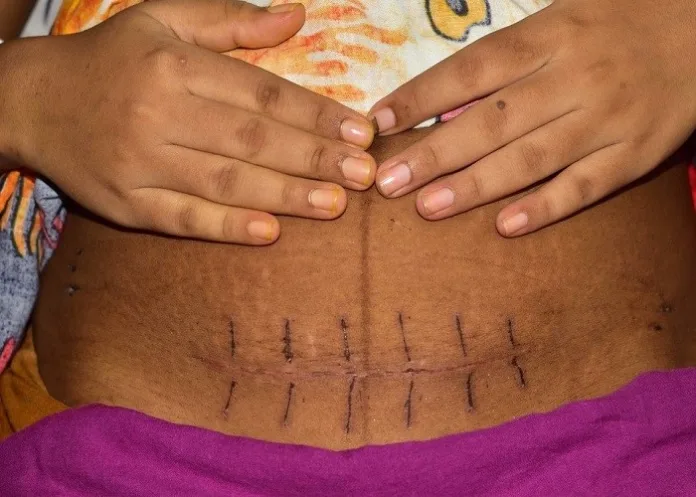An international study led by Dutch researchers has identified, for the first time, a condition caused by an abnormal uterine scar, the findings revealing that more than 30% of women who give birth by Caesarean section suffer from long-term symptoms like abdominal pain, blood loss or fertility problems.
The condition was defined by an international study led by Amsterdam UMC as Caesarean Scar Disorder (CSDi) and the research published in JAMA Network Open.
In the Netherlands, more than 30 000 women receive a C-section every year. Almost 60% of them develop a “niche”, the name for a defect in the uterine wall caused by impaired healing.
From the 18 000 with a niche, up to 10 000 women develop further symptoms or fertility problems.
Amsterdam UMC, the Dutch expertise centre for the treatment of niches, along with international experts, conducted research into these symptoms.
Until now, there has been no uniform definition for a condition that grouped these symptoms, making the comparison of research impossible while also leaving those with the condition in the dark.
International consensus
Medical researcher Saskia Klein Meuleman, gynaecologists Robert de Leeuw and Judith Huirne, examined relevant literature and designed a study to develop a uniform definition for niche-related problems. In total, 31 international experts from the US to China participated in this study.
All respondents treated at least 50 women a year with symptoms that fit the condition, and had published research on the subject.
They agreed on the symptoms that can be caused by a Caesarean scar, the aspects comprising the condition and the factors that can play a role. This created a clear picture of the condition, built on an international consensus.
Thanks to this research, women can now receive an accurate diagnosis and it will be easier to gain access to appropriate treatment. They can also be better informed about the possible long-term complications of a C-section.
Study details
Definition and Criteria for Diagnosing Caesarean Scar Disorder
Saskia Klein Meuleman, Ally Murji, Thierry van den Bosch, et al.
Published in JAMA Network Open on 29 March 2023
Key Points
Question How do experts define the clinical condition that constitutes a symptomatic niche in the uterine Caesarean scar?
Findings In this modified Delphi study, which included 31 international gynaecologists, consensus was achieved on the definition, symptoms, conditions to exclude, and diagnostic criteria of a Caesarean scar disorder, following a modified Delphi procedure.
Meaning Using a standardised definition for the constellation of symptoms resulting from a symptomatic uterine Caesarean scar will allow better recognition of this condition, improve patient care, prevent overtreatment, and create a patient-centric foundation of niche-related research in the future.
Abstract
Importance
Approximately 60% of women develop a uterine niche after a Caesarean delivery (CD). A niche is associated with various gynaecological symptoms including abnormal uterine bleeding, pain, and infertility, but there is little consensus in the literature on the distinction between the sonographic finding of a niche and the constellation of associated symptoms.
Objective
To achieve consensus on defining the clinical condition that constitutes a symptomatic uterine niche and agree upon diagnostic criteria and uniform nomenclature for this condition.
Design, Setting, and Participants
A consensus based modified electronic Delphi (eDelphi) study, with a predefined Rate of Agreement (RoA) of 70% or higher. Experts were selected according to their expertise with niche-related consultations, publications, and participation in expert groups and received online questionnaires between November 2021 and May 2022.
Main Outcomes and Measures
Definition, nomenclature, symptoms, conditions to exclude, and diagnostic criteria of an illness caused by a symptomatic uterine niche.
Results
In total, 31 of the 60 invited experts (51.7%) participated, of whom the majority worked in university-affiliated hospitals (28 of 31 [90.3%]), specialised in benign gynaecology (20 of 31 [64.5%]), and worked in Europe (24 of 31 [77.4%]). Three rounds were required to achieve consensus on all items. All participants underlined the relevance of a new term for a condition caused by a symptomatic niche and its differentiation from a sonographic finding only. Experts agreed to name this condition Caesarean scar disorder, defined as a uterine niche in combination with at least 1 primary or 2 secondary symptoms (RoA, 77.8%). Defined primary symptoms were postmenstrual spotting, pain during uterine bleeding, technical issues with catheter insertion during embryo transfer, and secondary unexplained infertility combined with intrauterine fluid. Secondary symptoms were dyspareunia, abnormal vaginal discharge, chronic pelvic pain, avoiding sexual intercourse, odour associated with abnormal blood loss, secondary unexplained infertility, secondary infertility despite assisted reproductive technology, negative self-image, and discomfort during participation in leisure activities. Consensus was also achieved on certain criteria that should be met and conditions that should be excluded before making the diagnosis.
Conclusions and Relevance
In this modified Delphi study, a panel of 31 international niche experts reached consensus for the constellation of symptoms secondary to a uterine niche and named it Caesarean scar disorder.
See more from MedicalBrief archives:
Baragwanath maternity unit faces R1bn negligence claims
Final report on UK maternity scandal that led to 100s of brain-damaged or stillborn babies
Natural birth obsession is a ‘tragedy’ for many mothers and their babies
Women who deliver by C-section are less likely to conceive again
7 babies stillborn in a single night at Harare Central Hospital

